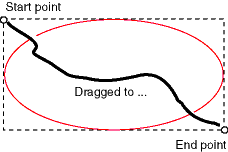Chapter 6

Events and Actions
Most of our lablets--indeed, most Java programs--take
advantage of Java's facilities for producing graphical, user-friendly
interfaces based on widgets and containers. Java's support for GUI
building blocks doesn't stop there, though. Built into every applet are
the methods needed to make our widgets respond to a full range of interface
events. In this chapter, we use two lablets to illustrate how one writes
programs that not only display the interface elements that we want on
the screen, but then actually respond to our button clicks, key presses,
and mouse movements.
 The
first lablet,
The
first lablet, GalaEvents, is an extension of our lablet
from Chapter 3, Gigobite. It demonstrates how to add
event handlers to an existing applet so that the applet recognizes and
responds to interface events. GalaEvents doesn't do
much in response to these events, but at least it recognizes them.
The second lablet, SketchPad, is a more complete example
that not only recognizes interface events, but responds to them in
interesting and useful ways.
Lab Objectives
 |
In this lab, you will: |
|
 |
Run and experiment with
the GalaEvents lablet to see the events it generates
and how to write code that handles these events. |
|
|
 |
Explore the code of
GalaEvents to see what is involved in event handling. |
|
|
 |
Run and experiment with
the SketchPad appelet. |
|
|
 |
Change SketchPad so
that it responde differently to some events. |
|
|
 |
Extend SketchPad
so that it recognizes and responds to some new events. |
|
Postlab Exercises
- In the interests of not confusing you about events, we did everything
we could in
SodaPop to hide the event-handling. The result,
unfortunately, was a program that was nowhere as clean as it could have
been. Go back to SodaPop and make the event handling as
tidy as possible.
- A real drawing program allows the user to draw more than just curves and
lines. For example, we might want to give the user the ability to draw ovals
and rectangles. Add a choice widget to
SketchPad that allows the
user to set the drawing mode to produce curves, as it does now, ovals, or
rectangles. For example, in oval mode, dragging the mouse and then releasing
the mouse button would draw an oval bounded by the rectangle whose opposite
corners are determined by the start and end of the dragged curve, like this:
You might want to allow two sub-modes for shape drawing, depending on whether
the oval or rectange is to be filled or just drawn as an outline.
Last updated: December 4, 1998
Rick Decker
Department of Computer Science
Hamilton College
Clinton, NY 13323
